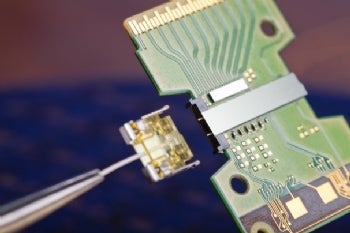Intel Turns to Light to Transfer Data Inside PCs
"Intel researchers said that the optical technology could ultimately replace the use of copper wires and electrons to carry data inside or around computers."
http://www.pcworld.com/article/202018/intel_turns_to_light_to_transfer_data_inside_pcs.html
This is an interesting article I though many here might enjoy reading.
I wonder if I could play with the concept by adding optical I/O to a Prop
chip by wiring an IR led and a phototransistor directly to it. You could
even have a processor with only the two power leads connected. It
would not be very practical, but would be fun to play with. I see this
optical data handling eventually leading to the demise of multi-layer
complex circuit boards as all data is sent using optical signals.

http://www.pcworld.com/article/202018/intel_turns_to_light_to_transfer_data_inside_pcs.html
This is an interesting article I though many here might enjoy reading.
I wonder if I could play with the concept by adding optical I/O to a Prop
chip by wiring an IR led and a phototransistor directly to it. You could
even have a processor with only the two power leads connected. It
would not be very practical, but would be fun to play with. I see this
optical data handling eventually leading to the demise of multi-layer
complex circuit boards as all data is sent using optical signals.


Comments
http://en.wikipedia.org/wiki/Photonic_crystal
Hidden most likely under title of national security because its apparently considered "national security" when only the criminals and secret societies involved in government have the "intel" and access to it and the super technologies its capable of.
The Smile they sell us is decades behind what they can REALLY manufacture.
Ever wonder why the cpu core clock speeds have remained CONSTANT for the last 8+ years?
Where is that 10ghz intel chip?
Even today the highest clock rate intel chip you can buy at affordable prices is still only 3ghz. (3ghz is even at the higher end today)
Lately they have been focusing on MIPS per Watt as heat is the barrier to higher speeds.
So apparently major, unlimited in funding, companies can't find some intelligent people to solve some not so difficult issues with heat piping, heat conduits, and OH MY GOSH, dare I say it?
THERMAL WAVEGUIDES???????????????????? (aka photonic crystal, LOL)
IM CALLING THE PRESIDENT OF INTEL OUT RIGHT HERE, WESTERN STYLE NOON DRAW.
If you can't do it, let me take over.
Paul Otellini, Intel Corporation president and CEO, DRAW.
Heck, I'll DRAW it all right in autocad.
Layer by layer.
Intel has a prototype 48 core chip(I beleive it was 2GHz).
Multi core has a big advantage over single core when you are using a multi threaded OS. Now if you are using dos you are out of luck.
For the next version of windows;)
-dan